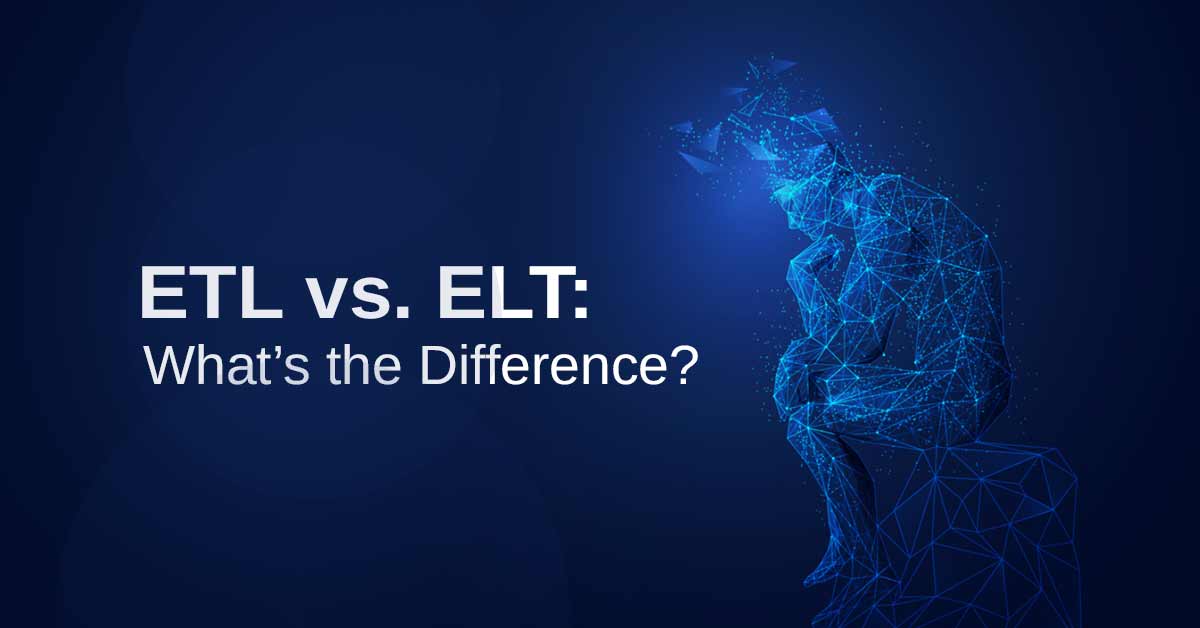ETL vs. ELT: What's the Difference?

Deep learning and machine learning specialist, well-versed with experience in Cloud infrastructure, Block-chain technologies and Big Data solutions.
February 11, 2021
Data Warehousing & Analytics
Data gets collected & managed from a variety of sources that aids in providing meaningful business insights. Apart from storing a vast amount of data, data warehousing gets used for connecting & analyzing business-data; a wonderful way to bring all the necessary data together. It forms the core of a Business Intelligence (BI) system that gets developed for data analytics.
Data warehousing blend technologies as well. It aids in the strategic use of data. Electronic storage of data, by a business, gets designed for queries & analysis instead of any other transactions. A process of data transforming gets done wherein proper & right information is made available to all users promptly; the huge advantage of data warehousing!
Three main types of data get saved in a data warehouse, which forms a central repository for all kinds of information; mostly business related. The structured, semi-structured, and unstructured data forms a crux of the data warehouse that in-turn gets categorized into three: Enterprise Data Warehouse (EDW), Operational Data Store, and Data Mart. The general stages of a data warehouse: offline, real-time, and integrated. Components of a data warehouse: load manager, warehouse manager, query manager, and end-user access tools. Steps for data warehouse implementation: enterprise strategy, phased delivery, and iterative prototyping.
All data accumulated in the warehouse gets used for analytics. ETL (Extract, Transform, & Load) forms the traditional approach for data warehousing & analytics and it has been that way for the last couple of decades. The arrival of ELT (Extract, Load, and Transform) brought in a new paradigm shift. All professionals & experts took note of this subtle change brought about when "load" came in before "transform". So, let's take a note of the difference between both approaches used in data warehousing & analytics. Read on this discussion and find out more about these approaches. So, let's begin! Shall we?
ETL vs. ELT: What's the Difference?
Businesses work by processing a vast amount, millions & billions, of data that gets collected from various events and processes (stored in data warehouses). The data must be clean, manageable, and ready to analyze (undergo the process of data analytics!). The data gets enriched, moulded, and transformed during the process of a thorough analysis. In the meantime, data starts looking meaningful with the right process of data-analytics. There are differences in the ways by which raw data gets managed, data-processing as well as the proper analysis.
E (Extraction): Retrieval of raw data from an unstructured pool. Migrating the data to a data-repository temporarily.
T (Transformation): Enriching & structuring the raw data to match the target source. A source that enhances business data & its possibilities.
L (Loading): Loading this structured data on to a data warehouse for analysis and to be used by Business Intelligence (BI) tools.
What's the ETL process?
We just now saw the definitions of Extraction, Transformation, and Loading. Now, let's look into the process of ETL. As observed, the ETL requires managing raw data that includes extracting all required information right. Data-transformations get done to ultimately serving all business needs. Each stage does require proper interactions by data engineers as well as developers. The capacity limitations of traditional data warehouses are dealt with as well. ETL gets used by analysts & other BI users as a simple acquiring of raw data is not sufficient to help run businesses and evolve them to bring in profitability.
Once the data get extracted, the loading phase gets switched on. Here on, all data sources get moved into a single and centralized data repository. With proper use of today's infrastructure technologies such as the cloud, all systems support large storage on a scalable computer. Hence, a large expanding data pool gets fast-processed while effectively maintaining all the extracted raw data.
It is no doubt that the ELT approach is a modern version of ETL. The process of ELT is still in evolving stages. All the frameworks & tools that support this process are still not fully developed enough for loading as well as processing a vast amount of data. All-in-all, the upside looks rather promising as it enables unlimited access to all data at any time. The ELT process saves time & effort for all data analysts as well as Business Intelligence (BI) users.
ELT: More efficient than ETL
Several hands-on examples demonstrate that ELT is more efficient & flexible than ETL. Users run more data-transformations with ELT than ETL. With ELT, one gets to test & enhance queries directly on raw data as is required.
How to Manage Data Warehouses and Data Lakes
Today's data management & integration needs of various businesses require small & big unstructured as well as structured data. For instance, a traditional Business Intelligence (BI) team needs to develop clear-cut best practices that support precise business objectives. The second mode of BI is more fluid with its high iterative-nature and helps in data-discovery. This type of observation sparked an interest in discussions about data warehouses as well as data lakes.
The concept of a data lake is a new way of thinking about big data that gets used for unstructured data. It is made for infinite scaling with tools such as Hadoop that aids in implementing the second mode of BI, which is flexible & aggressive. Many enterprises work well with data warehouses for supporting a traditional paradigm such as ETL. However, scalable modern data-warehouses such as BigQuery and other tools (Redshift) prefer ELT to bring in the modern benefits of technology.
Wisdom from IBM
According to IBM, modern big data projects need five things. It shows the need for new data concepts. The five V's comprise of volume, variety, velocity, veracity, and value. The volume of raw data is critical along with its variety: unstructured, semi-structured, or structured. The speed of data processing imbibes a trust element & value behind good data.
Benefit of using the ETL approach
Among both approaches, ETL continues to be a good match when it comes to the legacy of data warehouses. For instance, looking at small subsets while moving all information into data warehouses.
Benefit of using the ELT approach
ELT approach opens up much more opportunities as the working model is more fluid in an iterative BI environment. This approach works well due to its efficiency as well as flexibility. The ELT enables an implementation of many data warehouse concepts, which extend to various data lake concepts. It enables incorporation of unstructured data into its Business Intelligence (BI) solution.

Pros & cons of ETL as well as ELT
Load: ETL uses a staging area & system with extra time to load whereas ELT is an all-in-one system that needs to be loaded only once.
Transformation: ETL takes its time & hence, needs to wait especially for big sizes while the data grows and transformation time increases while ELT is an all-in-one system with speed not dependent on data-size.
Maintenance: With ELT, data is available always and hence it's a low-maintenance procedure whereas ETL is high maintenance with choices of data to load as well as transform.
Complexity of Implementation: ETL, at an early stage, requires less space; obtain a clean result. For ELT, one needs an in-depth knowledge of all required tools with an expert design of the main large data repository.
Processing Style as well as its Analysis: Analysis of ETL is based on multiple scripts that create several views. Deleting any view result in loss of data. ELT creates ad hoc views and it has a low cost for maintenance.
Data limitations with supply restrictions:For ETL, a data-set is presumed by choosing prior data while ELT works with a data retention policy.
Data Warehouse Support: For ETL, a prevalent legacy model gets used on-premises with regards to relational & structural data. ELT works with data tailored to scalable cloud infrastructure that supports both structured & unstructured big-data sources.
Data Lake Support: While ETL is not part of the approach, ELT enables the use of data-lake with ample support to unstructured data.
Usability: ETL has fixed tables, and timelines; usually used by IT whereas ELT is ad hoc, agile, flexible & used by anyone/everyone.
Cost-Effective: ETL is not at all cost-effective for SME enterprises whereas ELT is scalable & available to any kind of business regardless of its size by using online SaaS solutions.
Final Thoughts on ETL and ELT
The traditional ETL process is slowly getting outdated. In its prime, it had helped to cope with any limitations of traditional rigid & data centre infrastructures. The cloud is no longer a barrier for this kind of data these days. With an increase in data size, even only a few terabytes, the load-time take hours and depend on the complexity of data-transformation rules.
The modern ELT forms an important element concerning all future aspects of data warehousing. With the aid of ELT, businesses of any size get to capitalize on current technologies. Businesses gain key insights that create a real competitive advantage, which drives a business to evolve & excel with the help of its own data that it produces.
Conclusion
The data warehousing, data lakes, ETL, and ELT are linked together. The traditional ETL is making way for a modern ELT process that drives businesses forward. We discussed the key differences between ETL & ELT. Now, it's up to you for deciding to choose which, when, and how!













